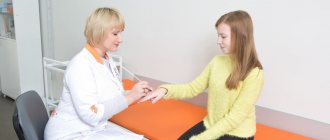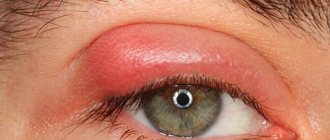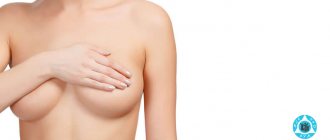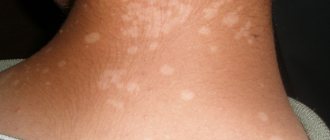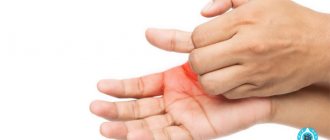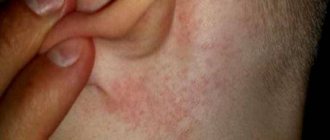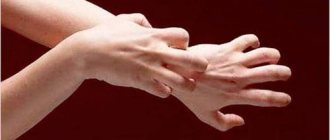What is itchy palms
Unpleasant sensations that are caused by internal nonspecific or external irritants of the external skin. This is the definition of itching. As a result, there is a desire to comb or rub a certain area of the skin or mucous membrane. Many nerve endings reach the surface of the epidermis, which is why such sensations can arise as a result of a variety of reasons - external and internal. The nature of itching is not fully understood. It is believed that this is a modified pain syndrome that provokes nerve endings.
Why do my palms itch?
The reasons why your palms itch can be very diverse. In some cases, itching is caused by serious diseases, the treatment of which can only be prescribed by a doctor. Among the more general reasons for the appearance of such sensations are the following:
- Allergy. This could be a negative reaction to the food eaten or substances with which the hands came into contact. Among the latter are powder, soap, cream, and dishwashing detergent. If the palm, fingers and other parts of the body itch, then such an allergy can be caused by animal hair, cold, dust or food.
- Psycho-emotional stress. Itching here is the body's reaction to external irritants.
- Increased sweating. For some it is hereditary, for others it occurs due to anxiety. This also leads to itching and even redness on the skin.
- Dry skin. A lack of water in the body also leads to the fact that the palms begin to itch, because the skin dries out and cracks, which can even cause pain.
More serious causes of itching include a number of skin diseases. They may be characterized by other additional symptoms, for example, burning or burning foci of inflammation. Such pathologies include:
- scabies (the spaces between the fingers begin to itch);
- eczema (added by a burning sensation and small rash);
- dermatitis (redness of the skin with itching is noted);
- lichen (redness and peeling occur);
- hives (accompanied by redness and then blisters that burst);
- fungal diseases (skin becomes thickened, nails and hair are additionally affected).
The fact that your palms itch may be a consequence of helminth damage to the body. This is how the skin reacts to the toxins released by these parasites. Causes of itching are often other infectious or viral diseases:
- lupus erythematosus;
- syphilis;
- diabetes;
- psoriasis.
Itchy palms, red spots
The presence of red spots on the palms, which are accompanied by itching, most often indicates an allergy or skin disease. They are characterized by rashes. Dermatitis is common in this case. They are caused by contact with irritants, such as cleaning chemicals. Allergies can manifest themselves in the form of pimples or larger spots. They itch and sometimes burn.
The combination of rash and itching is characteristic of hyperhidrosis, i.e. increased sweating. In this case, there is itching and spots on the feet. Palms often itch due to metal poisoning. The appearance of red spots on the palms is also accompanied by some diseases caused by bacteria, viruses or fungi. These include:
Burn and itch
A local increase in temperature on the palms indicates a number of skin diseases. This is observed with eczema, which has become a complication of an advanced allergic reaction. The same thing is found with scabies, when the parasite becomes active approximately in the evening and at night. Other causes of burning and itching palms:
- liver diseases, stones in the bile ducts (dry skin is a concern);
- excessive alcohol consumption (palms itch and burn);
- diabetes mellitus (burning hands and feet are observed along with thirst, increased appetite and headaches);
- vitamin B deficiency (accompanied by burning of the feet and hands, hair loss, brittle nails);
- polyarthritis (along with burning palms, morning stiffness of the joints is noted);
- carpal tunnel syndrome (sweating and burning of the palms).
Itching with peeling
If peeling appears along with itching, we can talk about a skin disease, for example, eczema. It is accompanied by dryness, cracks, and sometimes large blisters. The skin may be moist or dry. Another skin disease that is characterized by flaking is psoriasis. It may cause red spots of varying sizes to appear on the palms of your hands. Peeling will be observed in their center. The itching can be so severe that you want to rub your skin until it bleeds.
The degree of peeling is slightly lower in atopic dermatitis, a chronic hereditary disease characterized by periods of remission and exacerbation. Other causes of itching and peeling skin:
- age characteristics;
- increased skin dryness;
- failure to comply with drinking regime or strict hygiene rules;
- low indoor humidity.
How dangerous is the disease?
Allergic arthritis is dangerous because upon further contact with the allergen, acute allergic reactions such as Quincke's edema and anaphylactic shock can occur. Sometimes the disease can take a chronic course with gradual destruction of the joints.
Stages of allergic arthritis
In the typical course of the disease, three stages are distinguished:
- Early
– with an acute course, asymmetrical damage to the joints, increased body temperature, and malaise. In adults, the ankle and foot joints are more often affected, which is often accompanied by damage to the ligamentous apparatus, pain in the foot and heel. In children, in most cases, the hip and knee joints, as well as the joints of the lumbosacral spine, are initially affected. Symptoms: pain in the buttock and sacrum, slight lameness, general malaise, weakness, fever, urticaria. - Expanded
– inflammation of other joints is associated, also asymmetrical. The pain intensifies, the process becomes protracted. Children often develop skin rashes and swollen lymph nodes. The temperature is slightly elevated or normal. There are no changes on the x-ray. - Final
– the disease ends with complete recovery after 4 – 6 weeks.
Possible complications
With infectious-allergic inflammation of the joints against the background of chlamydia, the process can become chronic. The disease occurs with relapses and remissions, and the development of destructive disorders and gradual loss of joint function is possible.
In children, infectious-allergic arthritis can develop into juvenile rheumatoid arthritis (JRA) if there is a hereditary predisposition.
To prevent complications, it is very important to consult a doctor in time: the progression of the disease can be stopped at any stage.
Any form of arthritis has serious complications, so you should not delay treatment.
See how easily the disease can be cured in 10-12 sessions.
Itching and peeling of palms
Unpleasant sensations that are caused by internal nonspecific or external irritants of the outer skin are called itching. As a result, a person has a desire to comb or rub a specific area of the skin or mucous membrane. Nerve endings extend to the surfaces of the epidermis, which is why such sensations can arise for a variety of reasons: internal and external. Experts have not yet fully studied the nature of itching. It is assumed that this is a modified pain syndrome that provokes nerve endings. Very often, during itching, the skin on the fingers begins to peel off.
Causes of symptoms
The reasons why the palms of your hands itch can be very diverse. Sometimes itching can be caused by serious diseases, the treatment of which should only be prescribed by a specialist.
The most common common reasons for the formation of such sensations are:
- Allergic reaction. This can also include a negative reaction of the body to food eaten or substances with which the skin has been in contact. Among these are washing powder, creams, soaps, and dishwashing detergents. Palms, fingers and other parts of the body may itch due to an allergic reaction to animal fur, cold, food or dust.
- Psycho-emotional stress. Itching in this case is considered the body’s reaction to external irritating factors.
- Heavy sweating. In some people, excessive sweating is hereditary, while in others it occurs due to anxiety. In turn, this can lead to itching, redness and even peeling of the skin on the palms of the hands.
- Dry skin. An insufficient amount of water in the body can lead to the skin on the hands flaking, cracking, drying, peeling, which can even cause pain.
More serious causes include some skin diseases. As a rule, such diseases are characterized by other additional symptoms, for example, burning or burning of inflammation. Such diseases include:
- Scabies, in which the areas between the toes begin to itch.
- Eczema, which is accompanied by the formation of a small rash and burning sensation.
- Dermatitis, in which there is redness of the skin along with itching.
- Ringworm, which causes peeling and redness.
- Hives, accompanied by redness, after which blisters form, bursting after a while.
- Fungal diseases in which the skin becomes thickened, and hair and nails are also affected.
The palms may also itch due to helminth infestation . Thus, the skin reacts to the toxins that are released by these parasites. Itching can also be caused by other viral or infectious diseases. Such diseases include:
- Syphilis.
- Lupus erythematosus.
- Psoriasis.
- Diabetes.
Associated red spots
The presence of red spots on the palms, accompanied by itching, most often indicates an allergic reaction or skin diseases.
Such diseases are characterized by rashes. The most common in this case are various dermatitis. Dermatitis is caused by contact with irritating substances, for example, detergents or other chemicals for cleaning the apartment. Allergies can manifest themselves in the form of pimples or voluminous spots. Sometimes such tumors burn and itch. The combination of itching and rash is characteristic of hyperhidrosis, which is excessive sweating. In this situation, spots and itching still appear on the feet. Palms often itch after metal poisoning. The formation of red spots on the palms is accompanied by some diseases that are caused by fungus, viruses or bacteria. Such diseases include:
Increased body temperature
A local increase in temperature on the palms may indicate a number of skin diseases. Most often, this symptom is observed with eczema, which is a complication of advanced allergies. The same symptom can be found with scabies, when the parasite is active, around night and evening. Burning and itching of the palms can also occur for other reasons:
- Liver disease, existing stones in the bile ducts. In this case, the patient is concerned about dry skin.
- Excessive intake of alcoholic beverages. Palms burn and itch.
- Having diabetes mellitus, which causes burning of the hands and feet along with extreme thirst, headaches and increased appetite.
- Vitamin B deficiency, which causes burning of the hands and feet, hair loss, and broken nails.
- Polyarthritis. Simultaneously with the burning of the palms, morning stiffness of the patient’s joints is noted.
- Carpal tunnel syndrome, which causes burning and sweating of the palms.
The skin is peeling
If, simultaneously with the itching, the skin on the palms begins to peel and peel, then in this case we can talk about a skin disease, for example, eczema.
This disease is accompanied by the formation of cracks, dryness, and sometimes large blisters may appear. The skin may be dry or weepy. Another skin disease that is characterized by flaking is psoriasis. With this disease, red spots of varying sizes form on the palms, and the palms begin to peel off. Peeling is observed in the center of the formations. Sometimes it can be so strong that you want to rub your skin until it bleeds. Slightly less often, the skin peels off with atopic dermatitis, which is a chronic hereditary disease characterized by periods of exacerbation and remission. Other causes of peeling skin and itching:
- Increased dryness of the skin.
- Age characteristics.
- Low indoor air humidity.
- Failure to comply with hygiene or drinking rules.
Itchy baby's palms
Itchy palms in children are not often associated with any serious diseases, but their presence cannot be ruled out. It is best to seek help from a specialist who can accurately identify the root cause of such painful sensations. Most often, children complain that their palms itch when:
- Allergic reaction to food, animals, cosmetics or medications.
- Enterovirus infection, which is accompanied by the appearance of a rash on the chest and arms.
- Fungal infections, which are complemented by dryness and flaking.
- Scabies, in which the spaces between the fingers are very itchy.
- Lack of vitamins, when dry palms and irritation are also noted.
- Dyshidrosis, in which itchy blisters form on the palms, between the fingers and on the soles of the feet.
- Bites from ticks, bedbugs and other insects that often live in toys, old furniture and carpets.
- Hormonal imbalance or severe stress.
- Burns from some plants.
What is allergic arthritis
Allergic arthritis is an inflammation of the joints caused by an allergy to various particles entering the body. This disease develops especially often in children. Minor disruptions in the process of formation of the immune system lead, as a rule, to the development of an acute inflammatory process, which is easily treatable and ends without any consequences.
If the disease is based on complicated heredity, then sometimes the disease can become chronic with slow destruction of the joints.
The most common clinical form of this disease is infectious-allergic arthritis, which today is more often called reactive arthritis. According to statistics in our country, among rheumatic diseases, infectious-allergic arthritis in children under 14 years of age is more than 50%.
The code for allergic arthritis according to the International Classification of Diseases, 10th revision (ICD-10) is M13.8.
Allergic diseases can also include rheumatoid arthritis, which is based on an allergy to the patient’s own tissues. The ICD code for seropositive rheumatoid arthritis is M05.8; seronegative – M06.0.
Diagnosis of an unpleasant illness
To identify the main cause of peeling and itching , the doctor must perform a visual examination of the patient’s palms. Orally, he should inquire about how long ago the symptom appeared and study its severity. If serious illness is suspected, urine and blood tests may be ordered.
If the main cause is considered to be a skin pathology, then it is necessary to submit material to confirm the diagnosis. Most often, a smear is taken as a material from areas of inflammation on the palm.
Treatment with medications
The prescription of medications will directly depend on the reason why your palms itch. In general, a specialist may prescribe antiseptic, anti-inflammatory or antihistamine drugs to the patient. They can be presented in the form of medicines for internal use, as well as in the form of various ointments and creams for external use. However, some of them can only be sold with a doctor's prescription. Particularly effective external agents are:
Dyshidrotic eczema
It appears as a rash in the form of blisters. They can appear on such parts of the body as:
- Hands (between fingers).
- Soles of the feet.
With this disease, the child’s palms and soles of the feet itch more intensely at night. With this disease, weight decreases, the temperature rises at night, the child sweats, sleeps poorly and becomes less active.
If any of these signs occur, he should be taken to the doctor immediately.
Application of traditional methods of therapy
If your palms itch , you can use alternative medicine. Traditional methods of treatment can relieve attacks of itching, and also act as an auxiliary therapy for the main treatment. Traditional recipes use substances of plant origin. The most effective are non-traditional recipes:
- Take a glass of full-fat sour cream, add the juice of one lemon. Mix the ingredients thoroughly, add the yolk of one chicken egg. Apply the resulting mass to a medical bandage. Wrap the bandage around the affected areas of the skin on the palms, then wrap the hands again with cling film. The compress is kept in this position for 20 minutes, after which the composition must be washed off with warm water.
- Grate raw potatoes on a fine grater and apply the resulting mass to itchy palms. Wear rubber gloves on top of your palms so that the potatoes do not move from your hands. After 2 hours, remove the mask, rinse your hands with plain water, and lubricate the skin with nourishing lotion.
- Olive oil should be heated in a water bath, after which capsules with vitamins A and E should be dissolved in it. Add a few drops of essential oil to the resulting solution and mix everything thoroughly. The palms are lowered into the resulting composition, kept there for half an hour, after which they are thoroughly washed with warm water.
- Pour warm milk or water over a bowl of oatmeal and wait for the oatmeal to swell. Gently rub the resulting mass into the affected palms, and after 10 minutes, rinse with cool water.
- Place your palms in a large container and fill it with boiled water mixed with lemon juice, olive oil and sea salt. The palms are kept in this solution for half an hour, after which the hands should be washed with warm water and dried with a towel carefully, without damaging the epithelium.
- Pour whey or country yogurt into a bowl and heat the product to 20 degrees. Add one teaspoon of starch, mix everything thoroughly. Soak your palms in the resulting mixture for half an hour, then rinse with plain water and spread with nourishing cream.
- Pour two cups of boiling water over the leaves of mint, nettle, violet, lemon balm and burdock root and let it brew. When the composition has cooled, it should be consumed during the day at any time.
- Pour dill seeds with one glass of boiled water and let it brew. When the broth has cooled, it must be strained through a sieve and consumed throughout the day at any time.
- Take as many dried chamomile flowers and pour boiling water over them. When the infusion has cooled, it must be filtered and used as medicinal baths. Chamomile infusion has an anti-inflammatory effect, eliminates irritation, burning and other discomfort.
Before using any folk remedies, it is necessary to consult with a specialist, excluding the occurrence of allergies or aggravation of the condition. If severe itching occurs, even to the point of numbness in the hands, it is imperative to take action. The first aid here can be washing under a contrasting stream of water , and it is recommended to use antibacterial soap. Baths based on calendula, string and chamomile are also effective.
Main causes of itching and red spots
Itching is a skin irritation provoked by an external or internal pathogen, which causes a strong desire to scratch the affected area. The palms and soles have the largest number of nerve endings, which is why they are least protected from irritants.
If red spots on the feet and palms do not appear due to external factors, the cause is one of the diseases:
- Cholestasis, or cholestatic irritation with this symptomatology is considered first. If the diagnosis is confirmed, this indicates a generalized stage of the disease. It is characterized by a decrease in bile flow and an imbalance of bile acid in the blood. The development of the disease is influenced by alcohol intoxication, cirrhosis, pregnancy, medication, infection in the liver or pathologies of the esophagus and biliary tract.
- If there are problems with the endocrine system, children itch more at night than during the day. This is due to stronger blood flow to the extremities. Pathology of the thyroid gland and diabetes mellitus contribute to the development of a viral or fungal infection. In addition to scabies, a symptom is excessive dryness of the skin.
- Dyshidrosis, or dyshidrotic eczema, often appears on the palms and fingers, less often on the hands and feet. The disease is characterized by transparent blisters that are located deep under the skin.
Mild degree of dyshidrosis on the child’s palm
- Stress and nervous excitement are factors that cause itching and redness of the skin. Eczema, neurodermatitis or urticaria often appear due to an increase in the amount of histamines, bile acids and serotonin in the blood due to overwork and overexertion.
- Allergies in most cases are localized on the hands, but can also occur on the child’s legs. This reaction can be caused by hygiene products and washing powder, food and medicine, pollen, insect bites and dust.
- The cause of itching on the soles of the feet and palms may be a fungal infection. True, it does not occur as often in children as in adults.
- Enterovirus is a disease that affects human organs and skin. In the latter case, we are talking about a viral exanthema with significant redness and hyperemia of the skin. There is also a vesicular rash, in which the blisters disappear after a few days.
- With scabies of the extremities due to vitamin deficiency, patients experience excessive dry skin. Often, a lack of vitamins, especially group B, leads to the development of psoriasis.
On the palms
A number of the most common reasons why a child’s palms itch:
- allergy;
- violation of skin integrity;
- hyperhidrosis (increased sweating);
- metabolic disease;
- disease of internal organs;
- infectious or fungal disease;
- stress, depression, neurosis;
- skin disease;
- disorder of the autonomic nervous system;
- interaction with a chemical;
- pathology of the circulatory system.
On my feet
Complaints of itchy feet in babies are not uncommon. This symptom in the lower extremities appears for the following reasons:
- eczema of the skin;
- vascular disease;
- foot burn;
- allergic reaction;
- stress;
- abrasions, bruises, calluses and other injuries to the feet;
- leg discomfort due to tight, uncomfortable shoes;
- fungal disease.
Causes of allergic arthritis
The cause of allergic arthritis is the body's increased sensitivity to various environmental factors - allergens. Allergens can be various particles that enter the body - food, particles of skin or animal hair, fish scales, medications, infectious agents, etc. The disease can also develop in response to the introduction of a vaccine or serum.
The introduction of an allergen into the body causes sensitization - increased sensitivity of the body to a certain substance - antigen. In response to the introduction of this substance, the body produces antibodies that neutralize it. When this allergen enters the body again, antigen (allergen)-antibody complexes are formed, deposited on the walls of target organs and causing an inflammatory process. In case of allergic inflammation of the joints, the target organ is the internal synovial membrane lining its cavity.
Allergic arthritis in children in most cases is of an infectious-allergic nature. Its onset is associated with a bacterial or viral infection. Most often it is a streptococcal, staphylococcal, intestinal or chlamydial infection. The disease is acute, benign in nature and with proper treatment of arthritis ends in complete recovery.
In some cases, in the presence of a hereditary burden (close relatives suffering from allergic diseases), an allergy to the infection first develops, and then an allergy to the patient’s own tissues joins it. In arthritis, it is an allergy to intra-articular tissue. As a result, a long-term, recurrent autoimmune inflammatory process develops that destroys the affected joint - rheumatoid arthritis.
In addition to children, persons suffering from diabetes mellitus, cancer, AIDS, sexually transmitted infections, other allergic diseases and chronic arthritis of various etiologies are prone to the development of infectious-inflammatory arthritis.
Prevention
To avoid irritation on your palms and feet, you need to follow a number of rules. Preventive measures against itching on the extremities:
- adequate hygiene;
- exclusion of allergens;
- wearing comfortable, high-quality shoes;
- It is forbidden to put on or wear someone else’s shoes - the child should be explained that doing this is absolutely forbidden;
- balanced nutrition and walks in the fresh air;
- in public places, such as a swimming pool, do not walk barefoot, use only your own things;
- strengthening the immune system.
Your child’s palms and feet itch: how to treat itchy palms and soles
The child’s body reacts vividly to any external stimuli, as well as disruptions in the functioning of internal systems. The reasons can be serious or completely harmless and disappear within a day or two. But no symptoms should be ignored, even if the child’s palms are simply itchy. Firstly, the baby needs to be helped and the discomfort quickly eliminated, and secondly, a timely response to the problem can prevent the development of the disease.
General condition of the child
Sometimes a child’s palms and feet itch for seemingly no apparent reason. There can be many prerequisites for this, and the parent should pay attention to the child’s condition. First of all, you need to consider:
- baby's temperature;
- localization of irritation, i.e. whether it spreads throughout the body;
- Is scratching sharp?
- swelling;
- appearance of sores and type of blisters.
Why does a child's palms or feet itch?
The resulting discomfort prevents children from sleeping and staying awake. To eliminate itching of the feet and palms, it is necessary to determine the cause. These can be both everyday factors and serious pathologies of various types.
Enterovirus infection
The skin disease is characterized by redness in different parts of the body. The lesion is primarily noticeable on the upper torso and arms. Hyperemia does not protrude above the surface. Sometimes the palms and feet become covered with small blisters, which burst within a week, leaving pigment spots. Over time, the symptoms disappear without a trace.
Allergic diseases
Rashes in a baby, accompanied by severe itching, may be the result of contact with an allergen. This clinical picture is caused by various factors:
- Food. An allergy to any food is possible. First of all, you need to analyze changes in the diet, exclude new foods and observe the reaction. An allergy may also arise from an oversaturation of certain components of dishes that were constantly present on the baby’s menu and were well accepted by the body.
- Medicines. When taking medications, a child’s palms often itch, turn red, and become covered with blisters. You must inform your doctor about this so that he can prescribe a different course of treatment or adjust the therapy by selecting an additional antihistamine.
- External stimuli. In summer, a rash and itching on the palms may occur when picking berries and flowers. Baby's feet become red and itchy after walking on hot sand at the beach or barefoot on the grass. In winter, discomfort remains for several days after the hands or feet are frozen. A common irritant is household chemicals. A child’s feet itch severely if socks or tights are not rinsed well. The discomfort is more noticeable if your feet are sweaty.
- Disturbances in the operation of internal systems. Atopic dermatitis manifests itself as severe itching for no apparent reason. This may be a decrease in immunity, or the occurrence of diseases in a latent form.
If you have chronic itching, you need to undergo a full examination so that your doctor can prescribe treatment to get rid of the underlying cause. Only in this case will the fight against its symptoms be successful.
Fungal infection
If the skin flakes, flakes and itches very much, itching appears between the fingers and throughout the palm and foot, it could be a fungus. When neglected, the skin on the heels cracks. Fungal microorganisms contribute to the accumulation of toxins, which provokes the development of other diseases.
Scabies
Infection with parasites can be identified by severe itching and the presence of paired small nodules. This is the entrance and exit of the scabies mite tunnel that it makes under the skin. The child's palms itch more at night.
Irritation is caused both by the parasites themselves and by their metabolic products. If treatment is not started immediately, the infection will spread throughout the body.
Avitaminosis
The lack of useful components is characterized by increased dryness and itching of the feet and palms. Hands and feet become cold, tongue red and dry.
The most detrimental effect on the baby's condition is a deficiency of B vitamins.
Dyshidrotic eczema and dyshidrosis
The diseases have not been thoroughly studied. Doctors believe that they are provoked by nervous shock, problems with the immune and endocrine systems, excessive sweating, a tendency to allergies, and disruption of the sebaceous glands.
At first, the baby is bothered by strong tingling sensations, and only after a few days watery blisters appear on the palms of the hands and feet.
Other reasons
All body systems in a child are more sensitive than in an adult, so discomfort can be caused by various factors:
- Non-infectious skin diseases are characterized by severe itching. These are psoriasis, eczema, dermatitis. Pathologies are difficult to treat and after remission they can worsen again. Provoking factors are hereditary predisposition, allergies, food poisoning, low immunity.
- The child’s feet and palms are flaky and itchy due to worms. In the absence of other reasons, it is necessary to undergo tests to determine parasites.
- Without accompanying symptoms, palms itch due to lymphatic diseases. This mainly occurs when the number of platelets decreases and blood clotting deteriorates.
The same discomfort is caused by burns, injuries, and insect bites.
General recommendations
If spots appear on your child’s palms and itch, and this is not associated with serious illnesses, then try to follow the following recommendations:
- Do not use air fresheners and sprays in large quantities, watch what the baby does and what he eats. And if he starts helping you around the house, be sure to teach him to wear gloves.
- The child's shoes and clothes should be made of natural materials; monitor the baby's body temperature so that he does not sweat excessively.
- You should also pay attention to your shoes; they should not press or rub.
- Maintain your child's hygiene and clean the room twice a week as thoroughly as possible.
- Prolonged exposure to the sun is not advisable for the youngest children.
- The child's diet should be balanced, and new foods should be carefully tested. Let the baby try it in small portions first.
- Check with your doctor periodically.
